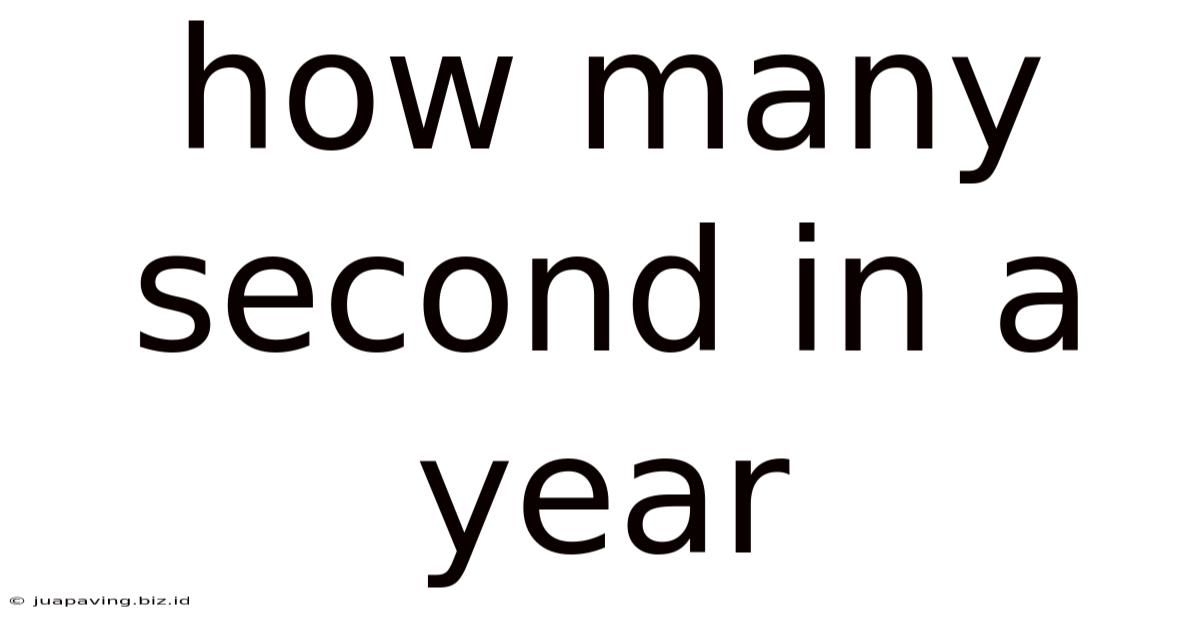How Many Second In A Year
Juapaving
May 14, 2025 · 4 min read

Table of Contents
How Many Seconds in a Year? A Deep Dive into Time Calculation
The question, "How many seconds are in a year?" seems simple enough. A quick calculation might spring to mind: 60 seconds in a minute, 60 minutes in an hour, 24 hours in a day, and approximately 365 days in a year. However, the true answer is more nuanced and delves into the fascinating complexities of our calendar system and the measurement of time itself. This article will explore the various ways to calculate the number of seconds in a year, factoring in leap years and the subtle differences between different calendar systems.
Understanding the Basics: Seconds, Minutes, Hours, and Days
Before we embark on calculating the seconds in a year, let's establish a firm foundation on the basic units of time. These are the building blocks upon which our larger calculations are based:
-
Second (s): The fundamental unit of time in the International System of Units (SI). It's defined as 9,192,631,770 cycles of the radiation corresponding to the transition between two hyperfine levels of the caesium-133 atom.
-
Minute (min): 60 seconds.
-
Hour (hr): 60 minutes, or 3600 seconds.
-
Day (d): 24 hours, or 86,400 seconds.
These units are universally accepted, forming the bedrock of our timekeeping systems.
Calculating Seconds in a Non-Leap Year
A non-leap year contains 365 days. Using the information above, we can perform a straightforward calculation:
365 days/year * 86,400 seconds/day = 31,536,000 seconds/year
Therefore, a non-leap year contains 31,536,000 seconds. This is a frequently cited figure, but it's only half the story.
The Leap Year Factor: Adding Seconds to the Equation
The Gregorian calendar, which is the most widely used calendar system globally, incorporates leap years to account for the Earth's slightly longer orbital period of approximately 365.2425 days. A leap year, occurring every four years (except for century years not divisible by 400), adds an extra day – February 29th – to the year. This adds a significant number of seconds to the total.
In a leap year, the calculation becomes:
366 days/year * 86,400 seconds/day = 31,622,400 seconds/year
Thus, a leap year boasts 31,622,400 seconds, a difference of 86,400 seconds (exactly one day) compared to a non-leap year.
The Average Year: A Statistical Approach
To get a truly average figure, we need to consider the frequency of leap years. Over a 400-year cycle in the Gregorian calendar, there are 97 leap years and 303 non-leap years. This allows us to calculate an average number of seconds per year:
[(303 years * 31,536,000 seconds/year) + (97 years * 31,622,400 seconds/year)] / 400 years = 31,557,600 seconds/year
Therefore, the average number of seconds in a year, considering the leap year cycle, is approximately 31,557,600 seconds. This is a more accurate representation than simply using the seconds in a non-leap year.
Beyond the Gregorian Calendar: Other Calendar Systems
While the Gregorian calendar dominates globally, other calendar systems exist, each with its own unique approach to calculating the year and, consequently, the number of seconds. The differences might seem minor, but they highlight the cultural and historical influences on our timekeeping practices. Variations in the number of days in a year, and the implementation (or absence) of leap years, would directly impact the total number of seconds.
The Significance of Precise Timekeeping
The accurate calculation of seconds in a year is not merely an academic exercise. It has significant implications across various fields:
-
Astronomy: Precise timekeeping is crucial for astronomical calculations, satellite navigation, and understanding celestial mechanics. The slight variations in the length of a year directly influence our understanding of planetary orbits and the movements of celestial bodies.
-
Navigation: Accurate timekeeping is fundamental to GPS technology and other navigation systems that rely on precise synchronization with satellites. Even small discrepancies in time can lead to significant errors in location determination.
-
Finance: Many financial transactions, especially those involving international markets, rely on precise timestamps. The number of seconds in a year can have implications for calculating interest and determining transaction times.
Beyond Seconds: Exploring Other Time Units
While seconds are the fundamental unit, it's valuable to expand our understanding to other time units:
- Millisecond (ms): 1/1000 of a second.
- Microsecond (µs): 1/1,000,000 of a second.
- Nanosecond (ns): 1/1,000,000,000 of a second.
- Picosecond (ps): 1/1,000,000,000,000 of a second.
These smaller units become increasingly crucial in fields like high-frequency trading, physics experiments, and advanced computing where incredibly precise timing is essential.
Conclusion: A Comprehensive Look at Time
The seemingly simple question of how many seconds are in a year reveals the intricate relationship between our calendar system, the Earth's orbit, and the precise measurement of time. While a quick calculation provides an approximate answer, a deeper understanding necessitates considering leap years and the average over a longer period. Furthermore, exploring other calendar systems and smaller time units highlights the multifaceted nature of time measurement and its crucial role in various aspects of modern life. Understanding these nuances helps us appreciate the complexities of timekeeping and its profound impact on our world.
Latest Posts
Latest Posts
-
How Many Gallons In 1000 Liters
May 14, 2025
-
Descriptive Words That Begin With O
May 14, 2025
-
Molar Mass Of K2 Cr2 O7
May 14, 2025
-
160 X 230 Cm In Square Feet
May 14, 2025
-
Is Plastic A Conductor Or Insulator
May 14, 2025
Related Post
Thank you for visiting our website which covers about How Many Second In A Year . We hope the information provided has been useful to you. Feel free to contact us if you have any questions or need further assistance. See you next time and don't miss to bookmark.